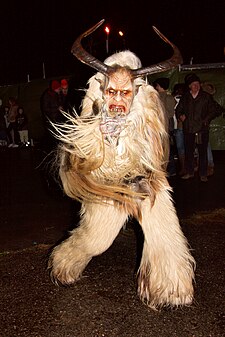Krampus
Krampus is represented as a beast-like creature, generally demonic in appearance. The creature has roots in Germanic folklore. Traditionally young men dress up as the Krampus in Austria, southern Bavaria, South Tyrol, northern Friuli, Hungary, Slovenia, the Czech Republic, the Slovak Republic and Croatia during the first week of December, particularly on the evening of 5 December (the eve of Saint Nicholas day on many church calendars), and roam the streets frightening children with rusty chains and bells. Krampus is featured on holiday greeting cards called Krampuskarten. There are many names for Krampus, as well as many regional variations in portrayal and celebration.
Origins

Modern history
In the 20th century, Austrian governments discouraged the practice. In the aftermath of the 1934 Austrian Civil War, the Krampus tradition was prohibited by the Dollfuss regime[4] under the Fatherland Front (Vaterländische Front) and the Christian Social Party. In the 1950s, the government distributed pamphlets titled "Krampus is an Evil Man".[5] Towards the end of the century, a popular resurgence of Krampus celebrations occurred and continues today.[6] There has been public debate in Austria in modern times about whether Krampus is appropriate for children.[7]Appearance
Although Krampus appears in many variations, most share some common physical characteristics. He is hairy, usually brown or black, and has the cloven hooves and horns of a goat. His long pointed tongue lolls out.[1][8]Krampus carries chains, thought to symbolize the binding of the Devil by the Christian Church. He thrashes the chains for dramatic effect. The chains are sometimes accompanied with bells of various sizes.[9] Of more pagan origins are the ruten, bundles of birch branches that Krampus carries and occasionally swats children with. The ruten have significance in pre-Christian pagan initiation rites.[1] The birch branches are replaced with a whip in some representations. Sometimes Krampus appears with a sack or a washtub strapped to his back; this is to cart off evil children for drowning, eating, or transport to Hell.[1]
Krampusnacht

Krampuslaufen
A Krampuslauf is a run of celebrants dressed as the beast, often fueled by alcohol. It is customary to offer a Krampus schnapps, a strong liqueur.[1] These runs may include perchten, similarly wild pagan spirits of Germanic folklore and sometimes female in representation, although the perchten are properly associated with the period between Winter Solstice and January 6. In larger cities, there may be numerous runs throughout the Advent season.[12]Krampuskarten
Europeans have been exchanging greeting cards featuring Krampus since the 1800s. Sometimes introduced with Gruß vom Krampus (Greetings from the Krampus), the cards usually have humorous rhymes and poems. Krampus is often featured looming menacingly over children. He is also shown as having one human foot and one cloven hoof. In some, Krampus has sexual overtones; he is pictured pursuing buxom women.[13] Over time, the representation of Krampus in the cards has changed; older versions have a more frightening Krampus, while modern versions have a cuter, more Cupid-like creature. Krampus has also adorned postcards and candy containers.[14]Regional variations
Krampus appears in various forms, and as part of differing celebrations, throughout central Europe. In Styria, the ruten bundles are presented by Krampus to families. The twigs are painted gold and displayed year-round in the house – a reminder to any child who has temporarily forgotten Krampus. In smaller, more isolated villages, the character has other beastly companions, such as the antlered “wild man” figures, and St. Nicholas is nowhere to be seen. These Styrian companions of Krampus are called Schabmänner or Rauhen.[1]A toned-down version is part of the popular Christmas markets in Austrian urban centres like Salzburg. In these, more tourist-friendly interpretations, Krampus is more humorous than fearsome.[15]
In the 1600s, the Lutheran Church presented a "christchild" figure in the place of the Catholic Saint Nicholas. Representing the baby Jesus but often appearing as a young maiden, this figure was also paired with Krampus in some areas. In France's Alsace region, Krampus is known as Hans Trapp and accompanies a "christchild" character during the holiday season.[11]
North American Krampus celebrations, though rare, are a growing phenomenon.[16] Some traditional Germanic communities in the northeast of the United States have preserved a Krampus tradition; in these he goes by Bellsnichol and combines aspects of both the wild man and Saint Nicholas.[11]



















0 komentar:
Posting Komentar